Yardley (post 1945)
Continued from: Yardley
The Second World War left Britain with a legacy of high taxation exchange controls and government regulation. Many Britains had little to spend on discretionary items like cosmetics and those that did often found it hard to purchase what they wanted due to quotas. In addition, it often took many years before some pre-war cosmetics became available once again. For example, Yardley’s Liquefying Cleansing Cream only reappeared in Britain in 1948.

Above: Yardley Old Bond Street. In the post-war years when a quota of soap and cosmetics became available at Yardley in Old Bond Street a queue developed that often stretched around the building.
Despite price reductions in 1950 Yardley sales in Britain remained restrained by the general level of austerity. However, the company was sound, making consolidated net profits of £469,926 in 1949 and £724,036 in 1950. Sales were helped by the British Government’s export drive, initiated to generate foreign reserves to pay for the country’s huge war-time balance-of-payments deficit.
Reorganisation and expansion
Yardley underwent a number of operational changes in the years following the war. The company moved its headquarters from Sackville House in Picadilly to Yardley House in Old Bond Street in 1945; acquired additional storage space at Carpenters Road in 1948; rented new premises in Horns Road, Ilford in 1950 to house finished stock and the dispatch department; and moved the warehouses and shipping department to rented premises in Green Street, Forest Gate in 1951. Manufacturing operations at Stratford were also updated and a new research laboratory was built there in 1950.
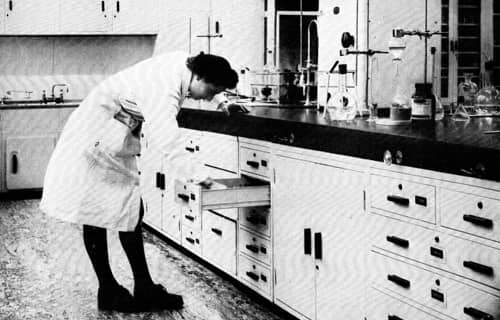
Above: 1950 New Yardley laboratory at Carpenters Road, Stratford used to conduct quality control, package testing, formulation research and production research for the Stratford factory and for plants in the United States, Canada, Australia and France.
In 1959, Yardley then consolidated a number of its operations at the newly renovated Yardley House in Old Bond Street.
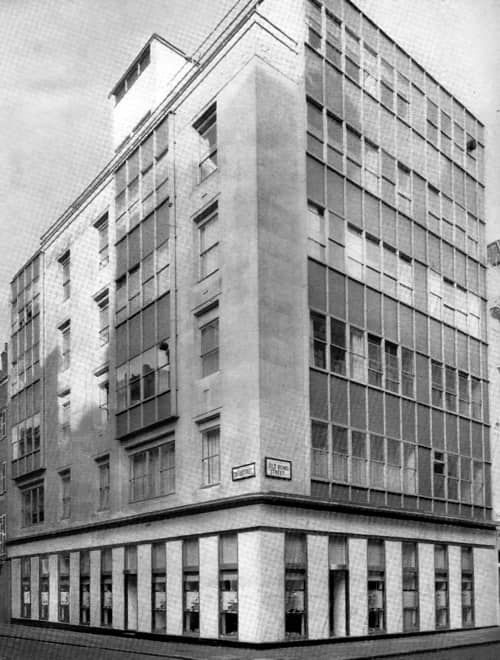
Above: 1959 Yardley House in Old Bond Street. The adjacent building, – purchased in 1937 to hold the beauty salon – has been increased in height with the addition of two extra floors and incorporated into the main building. The exterior has also been modernised with glass curtain walls to allow in more light.
Management of the company remained in the hands of the Gardner family. The last remaining Yardley with connections to the firm, Robert Blake Yardley [1858-1943] – a director of the company since 1890 – died during the war. T. Lyddon Gardner replaced Thornton Gardner [1873-1956] as company chairman in 1946; Richard. E. Gardner was appointed joint managing director in 1949, joining Lyddon Gardner’s brother, Rodney T. Gardner, who had been a managing director since 1938. A fourth member of the extended family, Charles E. Gardner, was made a company director in 1940.
As well as Yardley & Co. Ltd. in Great Britain, Yardley had subsidiaries in America (Yardley of London, Inc., Union City, New Jersey, with showrooms and sales offices in Fifth Avenue, New York); Canada (Yardley of London (Canada) Ltd., Toronto); France (Yardley et Cie, Paris); and Australia (Yardley and Company (Pty) Ltd., Sydney). By 1968, 68% of Yardley’s turnover was done overseas, generating 52% of the profits of Yardley as a whole (‘The Chemist and Druggist,’ 1965). Taxation associated with the growing revenues from overseas operations is probably the reason for Yardley & Co. Ltd. splitting its operations into two new companies – Yardley of London Ltd. and Yardley International Ltd. – in 1959. Yardley & Co. Ltd. then became a holding company.
Products
There was little in the way of new product development between 1945 and 1950 but the company quickly moved out of wartime packaging. Some containers and boxes were redesigned and Yardley began selling many of its cosmetics in new containers from 1946.
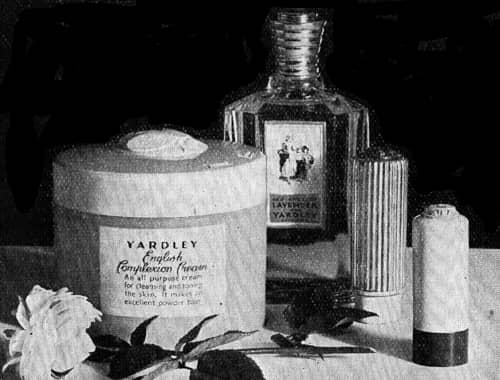
Above: 1946 Yardley cosmetics in redesigned packages. Most referenced the style of the pre-war packaging established by Reco Capey.
Skin-care
Yardley made some improvements to its skin-care lines in the 1950s. For example, vitamins A & C were added to the Night Cream which was then renamed as Vitamin Night Cream in 1954. It was to be used nightly on dry skins, every other night on normal skins and twice a week on skins that were oily. Vitamin E would not be added until 1973.
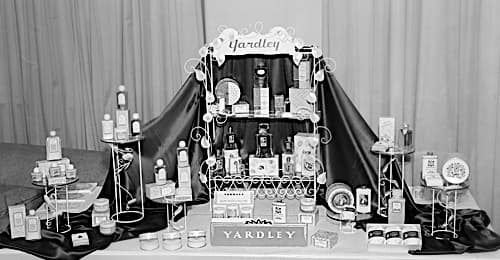
Above: 1954 Yardley window display (Australia).
There was also Improved Skin Food – although this was not available in the United States where the term ‘skin food’ was unusable after 1938 due to legislative constraints. The earlier introduction of Dry Skin Cleansing Cream also meant that English Complexion Cream was now referred to as an all-purpose cream.
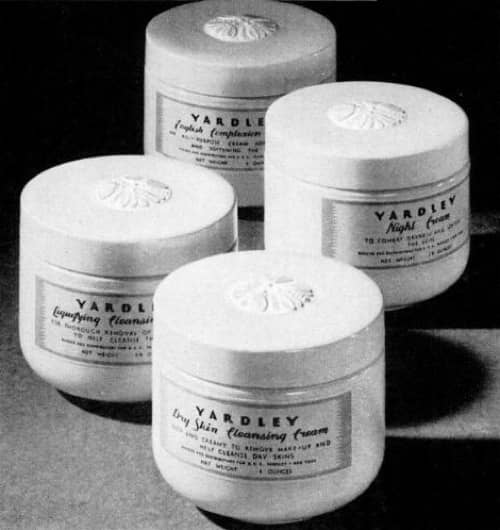
Above: 1952 Yardley English Complexion Cream, Liquefying Cleansing Cream, Dry Skin Cleansing Cream and Night Cream in package designs introduced in 1946.
In general, the message remained one of cleanse, nourish and tone.
If your skin is to be really beautiful, simple care with Yardley is essential. Never be slack about removing grime and make-up with soap and water, afterwards using Dry Skin Cleansing Cream and Toning Lotion. If your skin is greasy, substitute Liquefying Cleansing Cream and Astringent Lotion. Once or twice a week, condition your face and neck with Night Cream. Its bland richness vitalizes your skin, and keeps it clear and smooth.
(Yardley advertisement, 1952)
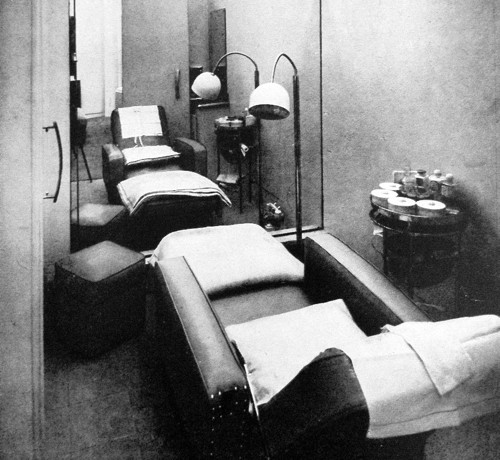
Above: 1948 Treatment booth in Yardley’s salon in London.
Make-up
Colour coordination became more sophisticated in the 1940s as allowances were made for a greater range of skin tones.
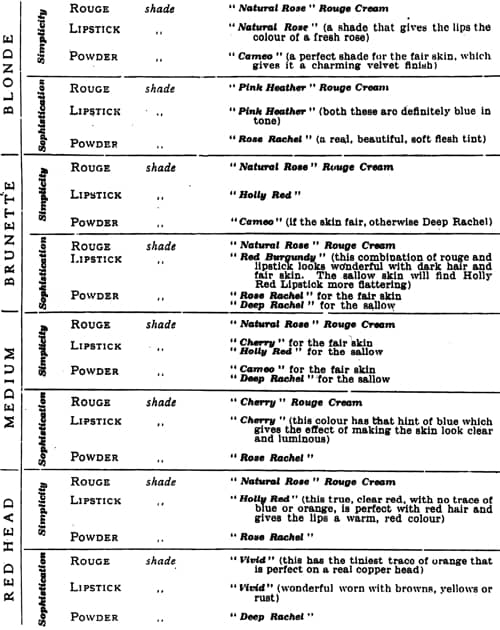
Above: 1947 Part of a Yardley make-up chart. The cosmetics have been place in two categories, Sophistication and Simplicity, which are interchangeable. This was for English customers so tan shades are notably absent.
Also see the company booklet: The Yardley Way to Beauty
Yardley also introduced new make-up lines. Feather Pressed, a pressed powder compact was added in 1950 in English Peach, Honey Glow, Golden Rachel, Rose Tan and Gypsy shades to complement Yardley Complexion Powder which now came in shades that included English Peach, Carmen, Pink Pearl, Champagne, Honey Glow, Golden Rachel Rose Tan, Copper Gold and Gypsy.
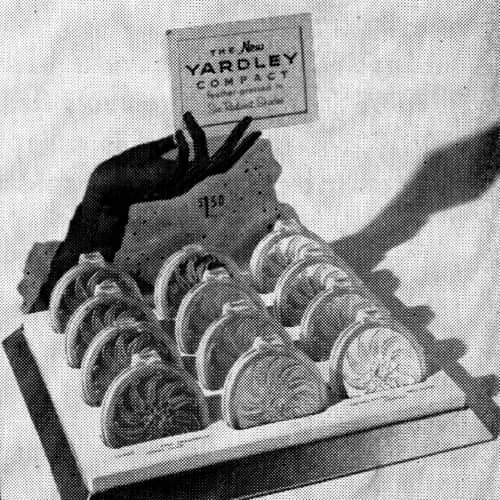
Above: 1954 Display of Yardley Feather-Pressed Compacts.
In 1955, Yardley then added Feather Finish, a cream powder compact in Blonde, Medium 1, Medium 2 and Brunette shades. There were also new foundations, including Feather Foundation and Moisture Make-up (1958), a powder base in Cameo, Pearl, Peach, Honey Blush and Capri tones.
A cake mascara was introduced and along with Yardley lipsticks, eyeshadows, eyeliners the Yardley make-up range underwent the usual ‘improvements in formulation’ and the addition of new lipstick colours – including Pretty Pink (1951), Bright Red (1952) Rose Coral (1953), Calypso Pink (1958) and Ace of Hearts (1959).
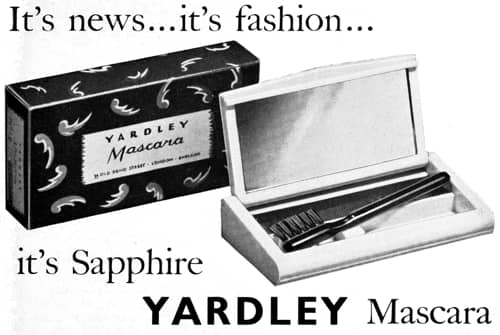
Above: 1958 New sapphire shade of Yardley Mascara.
American market
During the 1950s it became clear to Yardley management that the company needed to improve its presence in the United States, then the largest single market for toiletries and cosmetics. Yardley products and pricing meant that its lines were best suited to department stores but its position there was weak and Yardley was in danger of being squeezed from both the high and low ends of the market into a dangerous middle position.
In 1955, the Yardley of London (New York) introduced a new range of cosmetics designed to bolster its position in America and in department stores in particular. The new line consisted of sixteen products including eight make-up items – Feather Foundation, Face Powder, Formula 33 Lipstick, Liquid Rouge, Cream Rouge, Eye Shadow, Mascara and Eye Pencil – seven treatment items – Captive Beauty, a liquid emollient, Vitalyn Cream, a vitamin cream, Face Mask, Cleansing Milk, Skin Freshener and Dry Skin Cleansing Cream – and an anti-perspirant. Some of these products were sold in other parts of the world but many remained specific to the United States. Although promising, the line failed to have any real impact on the sale of Yardley cosmetics in America and it would not be until after 1964 that there would be any real improvement.
In 1958, the American subsidiary did have considerable success with Spray Mist – generally regarded as the first commercially successful aerosol perfume. It came in Bond Street, English Lavender, Flair and April Violets perfumes with Red Roses introduced the following year. Following its release in the United states it became available in Great Britain and elsewhere from 1960 onwards.
See also: Aerosol Cosmetics
In 1959, when W. A. Poucher retired, Yardley moved its main research facilities from Britain to the United States, opening a new research division, Yardley International Research Laboratories, near the factory in Union City, New Jersey. The move was a recognition of the importance of the American market and the leading role the United States played in product development at that time. Sabbat J. Strianse was appointed director of research in the new facility.
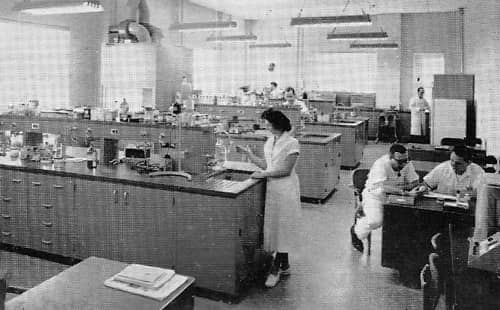
Above: 1960 General view of the laboratory in Union City, New Jersey.
In 1961, Yardley further increased its commitment to the American market by building a new US$3 million factory in Totowa, New Jersey.
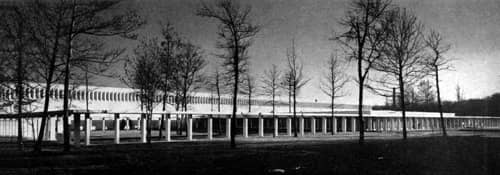
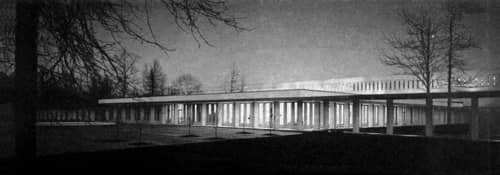
Above: Office, manufacturing and warehouse buildings for Yardley in Totowa, New Jersey. Architect Edward Durell Stone [1902-1978].
In Britain, Yardley consolidated its manufacturing facilities in a new site. The company had been refused permission to enlarge the site at Stratford as all available land was required for schools and housing. In 1963, Yardley acquire a lease on a 10-acre site in Basildon New Town, Essex and after building a factory there began transferring its operations and warehouses to the new plant in 1965, completing the move early in 1966.
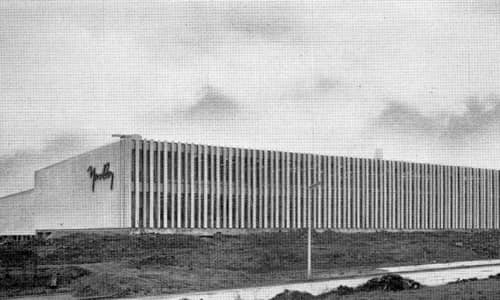
Above: 1966 Yardley factory at 4 Miles Gray Road, Basildon.
Products
The most important product development for Yardley during the 1960s was its heavy investment in colour cosmetics for teenagers and younger women which began in earnest in the American market. However, there were also additions and changes to Yardley’s skin-care range.
Skin-care
For the Yardley skin-care range, change in the 1960s was one of evolution rather than revolution. There were additional products for mature women, the growing youth market and other specialised skin problems. Noticeably missing were any of the more extreme anti-ageing fads that periodically swept through the beauty industry.
As with other companies, moisturisers were added to Yardley’s skin-care line during this time including Moisture Magic (1961) and Velvet Skin Moisturiser (1967), the former a cream the later a lotion.
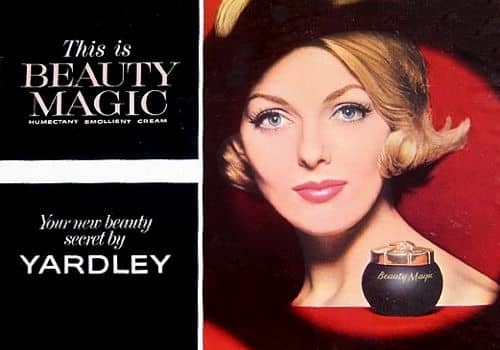
Above: Yardley Beauty Magic.
Deep Emollient Cleanser: “[C]ontains eleven emollients to cleanse deeply”.
Skin Freshener: “pH controlled to balance skin acidity and tone the skin”.
Improved Vitamin Cream: “[A] vitamin enriched night cream to combat dryness and roughness, tiny lines and wrinkles”.
Special Dry Skin Cleansing Cream: “[T]o cleanse gently but deeply and thoroughly”.
Complexion and Foundation Cream: “[A] light untinted all-purpose cream”.
Infinite Beauty: “[R]ich luxury cream to counteract tired lines and loss of skin firmness”.
Beauty Magic: “[I]t’s a cream full of moisture … keeps skin young, glowing”.
Velvet Skin Moisturiser: “[A] moisturising liquid to retain essential skin moisture”.
Eye Contour Oil: “[T]o stop the tiny lines and wrinkles from deepening”.
Although moisturising is given its due, the importance of oils in ‘nourishing’ the skin remained central to Yardley’s skin-care message.
Just as our bodies need good food so our skins need nourishing. When we are born nature provides us with an abundance of natural oils to keep our skins soft and smooth but sad to say, as we grow older these natural oils gradually dry out and lines, wrinkles, flabbiness and general loss of colour occur.
To prevent further loss of these oils, and, as far as possible to replace them is the aim of the Yardley nourishing creams.
Again, like our bodies, our skins also need some exercise so we combine the two—nourishment and exercise by gently massaging in to our skins Improved Vitamin night Cream.
But first we must prepare our skin to accept this nourishment and exercise. So we repeat out morning treatment wash, deep pore cleanse and freshen. The use of Yardley Skin Freshener helps prepare the skin for the benefits of your night treatment cream.
For very dry skins, and this applies too to the mature skin, it’s a good idea to use Improved Vitamin Night Cream one night and Infinite Beauty the next and to continue these on alternate nights—but don’t forget Infinite Beauty must not be massaged in.
Oily skins of course need no additional oils so they do not use a nourishing cream. They use Beauty Magic to replenish their supply of moisture.
Next step is the sheerest possible film of Contour Control over your treatment cream. This helps trap the moisture in your nourishing cream or Beauty Magic, which ever you are using, and holds it in while you sleep.
Last but by no means least a few drops of Eye Contour Control on eyelids and underneath the eyes. This exceptionally absorbent blend of rare oils is specifically designed to protect the delicate skinned eye area against cobweb lines and actual wrinkles. Because there are no oil ducts around the eye area to keep the skin soft and supple even an oily skin needs Eye Contour Oil to keep lines and wrinkles from forming.(Yardley article on beauty care, 1967)
Massaging the skin also remained an important part of Yardley beauty treatments.
First the skin must be thoroughly cleansed night and morning. Start with a soap and water wash using luke-warm water and Yardley Oatmeal Soap (if your skin is dry or sensitive) a Yardley perfumed soap if your skin is oily. This removes the buildup of make-up, secretion of skin oils and daily grime.
Next deep pore cleanse with Special Dry Skin Cleansing Cream or Deep Emollient Cleanser if your skin tends to be oily.
Next step, tone up your skin with Yardley Skin Freshener which conditions your skin as well as freshening it. This means it has the ability to make dry skins less dry and oily skins less oily—it also contains a mild antiperspirant to keep skin cool and dry in hot weather.
In the daytime you follow this with a moisturizer – Velvet Skin moisturizer for dry and sensitive skins—Beauty Magic for all others. …
Next step is the sheerest possible film of Contour Control. This product does two things—it helps smooth out surface wrinkles and lines thus creating a more youthful appearance and for oily skins and skins which perspire excessively it provides a transparent filmy base for even make-up application and keeps make-up looking fresher longer which is a major problem with moist or oily skin. …
Now apply a little of the Improved Vitamin Night Cream—spread lightly over the face and throat and using the pads of the fingers gently massage into the skin with an upward and outward movement. Continue this gentle massage for five to 10 minutes—then tissue off any excess.
If you are the lazy type or just don’t like any form of massage then use Infinite Beauty. This cream has been specially designed to do its job without any massage. Simply spread a light film over the skin and leave it.
Please note if you have a sensitive skin Infinite Beauty is not for you—it’s too stimulating—so you’d just smooth a little of Improved Vitamin Night Cream over your face and throat and forget it is there.(Yardley article on beauty care, 1967)
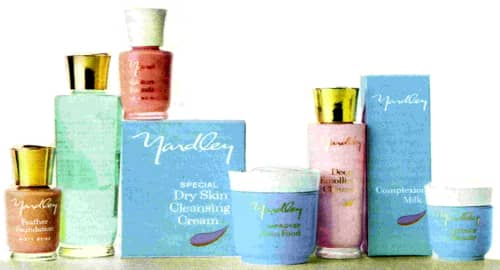
Above: 1964 Yardley skin-care lines sold in Australia. Products shown are Feather Foundation, Skin Freshener, Moisture Tint Foundation, Special Dry Cleansing Cream, Improved Skin Food, Deep Emollient Cream, Complexion Milk and Infinite Beauty.
Make-up
In 1960, Yardley introduced new golden Florentine lipstick cases with lipsticks in Pink Diamond, Pink Fizz, Persian Pink, Cuban Rose, Venetian Rose, Roulette, Baccarat and Solitaire shades, and followed this with a matching Florentine Compact. Refills could be purchased for these lipsticks but not for Moisture Creme Lipsticks released in 1963.
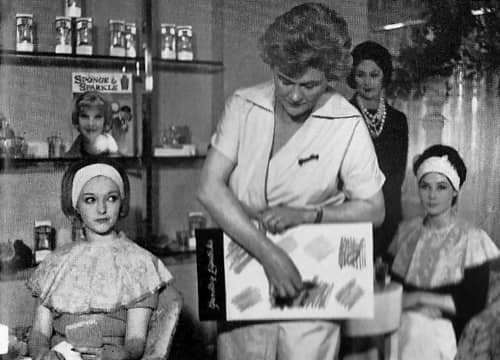
Above: 1961 Mrs. Riddell demonstrating shades of Yardley lipsticks to watching models.
For Yardley foundations and powders, these followed on from previous developments.
Most skins unless very young look best with a foundation and loose powder. Yardley makes two foundations—Moisture Tint for dry and normal skins. Feather Foundation for the oily types.
If your skin is inclined to have a flushed appearance chose a shade of foundation and matching face powder in a beige toning which will make your skin look cooler.
If on the other hand your skin looks sallow or olive, try a shade with a little pink or rose in it to give it warmth. For touch ups during the day use Yardley Feather Finish Cream Powder in compact form. …
Blush Tone is available for those who like a little rouge to add colour to the cheeks. Chose a shade to blend in with your lipstick.(Yardley article on beauty care, 1967)
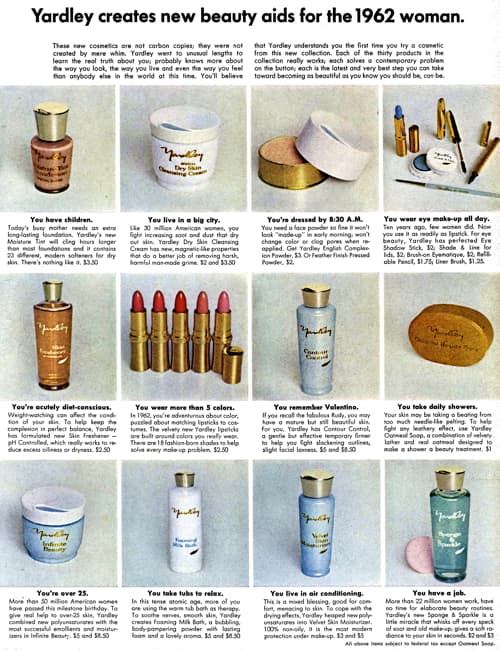
Above: 1962 Yardley products (United States). Products shown are:
Top: Moisture Tint, Dry Skin Cleansing Cream, English Complexion Powder, and Eye Make-up.
Middle: Skin Freshener, Lipsticks, Contour Control, and Oatmeal Beauty Soap.
Bottom: Infinite Cream, Foaming Milk Bath, Velvet Skin Moisturizer, and Sponge and Sparkle.
Youth market and the London Look
As mentioned earlier, the biggest developments in Yardley cosmetics in the 1960s were in products aimed at teenagers and younger women. Yardley had been interested in this market since the war. In 1946, it had developed a beauty book for teenage girls called Junior Miss with subsequent editions released in 1950 and 1953. In 1950, Olive Cato had also started The Teenage Club which had some 20,000 members by 1966. The beauty department in London also answered letters from teenagers and gave lectures and demonstrations on using Yardley products.
In the 1950s, Yardley had developed a limited range of skin-care products for teenage and problem skins. In 1951, it brought back Oatmeal Complexion Soap with an improved formula and then, in 1959, introduced Clearskin, a greaseless cream designed to help control blemishes.
Although these initiatives were important their impact was dwarfed by American developments after 1964, which were in large part due to one man, Donald D. Burr.
Donald D. Burr
Despite attempts to rectify the problem, sales of Yardley products in the United States were still languishing. To rectify the situation Yardley engaged Donald D. Burr in 1964, making him vice president in charge of marketing in the United States and giving him overall responsibility for the sale, merchandising and marketing of Yardley products there.
Burr’s previous experience included time with Hazel Bishop, where he rose to become company president in 1955, and Rayette – the makers of Aqua-Net Hair Spray – where he held the position of vice-president in charge of marketing.
Burr conducted a national study to determine who bought Yardley products. This identified the average Yardley customer in America as being close to fifty. Unless this was addressed sales would continue to decline. In addition, most of Yardley’s business in America was in soaps and fragrances with cosmetic sales running at under US$150,000 annually in 1964.
As Yardley was an English firm, Burr took advantage of that brief period in the 1960s when Britain became the world centre of music and fashion, and London became ‘Swinging London’ as epitomised by the Beatles, the Rolling Stones, Carnaby Street and King’s Row, and used it to sell Yardley cosmetics to a younger customer base.
In 1965, using an advertising campaign created by Jacqueline Brandwynne [b.1937], Burr launched the ‘London Look’ in the Rockefeller Center in New York and followed this with tours of department stores across the country using models who embodied the London Look to demonstrate the cosmetics. Called Yardley Beauty Bashes these department store promotions featured fashion, films and cosmetic samples and drew in thousands of teenage girls. They were followed up with a quarterly magazine called the ‘Yardley Beauty Beat’ which reached 1½ million subscribers in the United States and produced over 1,200 letters to Yardley each week (Uris, 1969, p. 158).
Make-up for the London Look consisted of a pale, matt finish with a heavy focus on the eyes. It was given ‘mod’ names – such as Sigh Shadow eye shadow, Slicker Dolly lipstick and Pot O’Gloss lipgloss – was packaged in bright pop colours we now equate with the 1960s, and was promoted using well-known English models such as Jean Shrimpton and Twiggy.
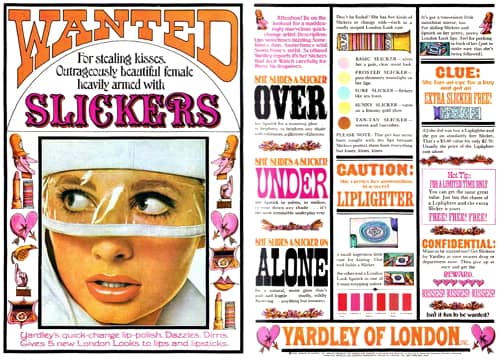
Above: 1966 Yardley Slickers
English Eyelighter: “[M]akes your eyes look twice the size.”
Sigh Shadow: “[B]rush on powders in low-key colors flutter on like a whisper and make eyes look not once, but twice the size!” Shades included: Heather Green, Foggy Grey, Aqua Tint, Oxford Brown and Lavender Blue.
London Lashes: “[M]akes lashes look as flirty as false ones without the bother.”
English Eyeliner: “[A] knockout mascara.“
New to Nothing Foundation: “The sheerest face film that actually lets your skin glow through.” Shades: Bare, Buff, Bloom and Blush.
London Fluff: “See through powder that settles light over Next to Nothing Foundation.” Shades: Bare and Buff.
London Fluff Pressed Powder: “The carry-cake compact.” Shades: Bare and Buff.
Slickers: “[T]urn on lips or lipstick. Make your mouth all softness and shine.” Shades included: Basic Slicker, Helpless Pink, Beach Melon, Eastside, London Luv Pink, Good Night, Sunny Slicker, Frosted Slicker, Surf Slicker, Chelsea Pink, Piccadilly, Dicey Peach, Nippy Beige, Tan-Tan and Nectaringo.
Slicker Nail Polish: “[C]aptures kisses down to your fingertips.”
Burr’s promotional efforts were very successful. Between 1964 and 1968 Yardley sales in America rose from US$12 million a year to US$40 million. In particular, sales of cosmetics showed big gains rising from US$150,000 to US$20 million (Observer Reporter, 1968) with the main customers being teenagers and young women. Yardley lines developed in the United States were also sold by Yardley in other countries, magnifying the financial benefits to the company.
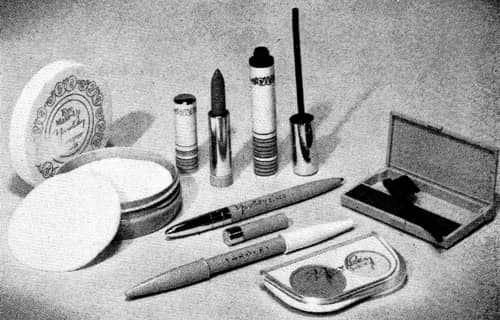
Above: 1966 Yardley make-up.
By 1968, manufacturing and shipping space had almost doubled in the Yardley facilities in Totowa, and Yardley employees in the United States had risen from 400 to over 1,000 with big increases in staff numbers in sales and marketing. Burr was rewarded by being made executive vice-president in 1966 and then president of Yardley of London, Inc. (New York) in 1968.
Burr’s decision to concentrate on the youth market was not without its problems in the longer term. It required Yardley to become deeply involved in the fashion cycle, something it had not heavily engaged with before. Cosmetics driven by rapid fashion changes required shorter product turnovers and large advertising budgets to be successful and could have disastrous financial consequences if predictions were misjudged. As Yardley would discover, the youth market was very fickle and before long the company began to experience heavy financial losses in the American market as out of fashion product went unsold (Jones, 2010). It also moved Yardley downmarket, a trend the company repeated in Britain when it began to be sold in British Home Stores.
Corporate acquisition
In 1967, Yardley was bought by British American Tobacco (BAT). The Gardner family and their associates, who controlled almost three-quarters of the votes, agreed to the deal after BAT improved their offer. The sale was followed by operational rationalisations. In Australia, production of Yardley products was combined with Morny and Lentheric, companies also owned by BAT. Lentheric and Yardley operations were also merged in Germany and in the United States.
In 1970, the cosmetic companies owned by BAT – Yardley, Morny, Germaine Monteil, Juvena, Lenthéric, Scandia and Tuvaché were combined into a separate division, British American Cosmetics (BAC), but after a management change at BAT – that returned to concentrating on tobacco – the cosmetic division was sold Beecham in 1985.
In 1989, Beecham merged with SmithKIine to form SmithKIine Beecham and, as with BAT, the new entity decided to concentrate on its core business, pharmaceuticals. Yardley was sold once again, this time to Wasserstein Perella & Co. and operated through the Old Bond Street Corporation. In 1998, Yardley went into receivership with debts of about £120 million. However, despite suffering a series of sales and subdivisions the brand still operates in a number of countries although with a very much reduced range of fragrances, soaps, body washes and shaving products.
Timeline
| 1946 | Yardley head office, perfume laboratory, art department and salon moved to Yardley House, London. |
| 1951 | The first British depot outside London opened in Liverpool. New Products: Feather Pressed, a pressed powder compact; Yardley Y range of men’s toiletries. |
| 1954 | New Products: Vitamin Night Cream. |
| 1955 | Yardley of London (Africa) Pty. Ltd. established. New Products: Feather Finish, a pressed cream compact. |
| 1958 | New Products: Moisture Make-up, a powder base. |
| 1959 | Yardley House in Old Bond Street extended and modernised; and Yardley International Research Laboratories established in Union City, New Jersey. New Products: Clearskin spot and blemish cream; and Three Beauties Powder, Lipstick and Cream Powder. |
| 1960 | New Products: Air-Flow Hand Cream, in pressurised container; and Florentine lipstick case. |
| 1961 | New American Yardley factory built in Union Avenue, Totowa, New Jersey. New Products: Beauty Magic, a moisturiser; Sponge and Sparkle, cleansing and toning liquid; and Roll-on Antiperspirant Deodorant for Men. |
| 1962 | New Products: Special Vitamin Hand Care Cream with vitamins A and D; Flair and Lavender Foam Baths; Rose Antiperspirant Deodorant; and Hair-Control Series for Men in cream and lotion. |
| 1963 | Yardley Dusting Powders repackaged in plastic packs. New Products: Moisture Creme Lipsticks. |
| 1964 | Yardley of London Ltd. and Yardley International Ltd. created. |
| 1965 | New Products: Lip Slickers; Jaguar men’s line; Pace Setter, a hair spray. |
| 1966 | Yardley relocates from High Street, Stratford to Miles Gray Road, Basildon. New Products: Jean Shrimpton line; and improved formula Clearskin. |
| 1967 | Yardley now sold in British Home Stores; Yardley acquired by British American Tobacco (BAT). New Products: Velvet Skin Moisturiser; and Oatmeal Beauty Treats line. |
| 1968 | New Products: Khadine, fragrance and bath line; and Next to Nothing make-up range. |
| 1970 | Yardley grouped into British American Cosmetics (BAC). |
| 1984 | Yardley acquired by Beecham. |
| 1989 | Beecham merges with SmithKline to form SmithKline Beecham. |
| 1990 | SmithKline Beecham sells its Yardley-Lenthéric cosmetics group to the investor group Wasserstein Perella to be operated through the Old Bond Street Corporation. |
| 1992 | Yardley of London (Africa) Pty. Ltd. acquired by National Brands Ltd., a subsidiary of AVI Ltd. |
| 1998 | Yardley goes into receivership. Yardley (U.K.) acquired by Wella. Yardley London trademark for sub-Saharan Africa secured by National Brands Limited. |
| 2001 | Yardley U.S. acquired by Wella. |
| 2005 | Yardley acquired by The Lornamead Group. |
| 2009 | Lornamead sells Yardley Asian and Middle Eastern rights to Wipro. |
| 2012 | Lornamead sells the U.K./European division of Yardley, with the exception of Germany and Austria, to Wipro. |
First Posted: 5th March 2012
Last Update: 29th December 2020
References
The chemist and druggist. (1859-) London: Morgan Brothers.
Jones, G. (2010). Beauty imagined: A history of the global beauty industry. Oxford: Oxford University Press.
Poucher, W. A. (1932). Perfumes, cosmetics and soaps (4th ed., Vols. 1-2). London: Chapman and Hall Ltd.
Thomas. E. (1953). The house of Yardley 1770-1953. London: Sylvan Press.
Uris, A. (1969). The strategy of success. London: The Macmillan Company.
Yardley & Co. Ltd. (c.1949). The Yardley way to beauty [Booklet]. London: Author.
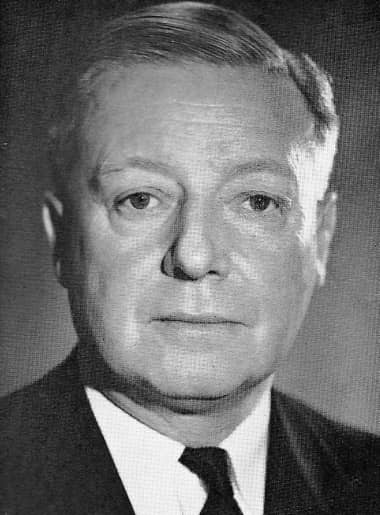
Thomas Lyddon Gardner [1904-1969]. This photo was taken c.1968.
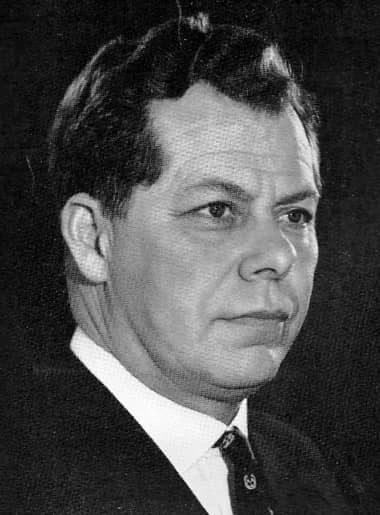
Richard Exton (Jimmy) Gardner [1914-1999]. He joined the Royal Navy in 1939 becoming a pilot in 1940. He left the service in 1946 to became a director at Yardley and then joint managing director in 1949 before replacing Lyddon Yardley as chairman in 1968. This photo was taken about then.
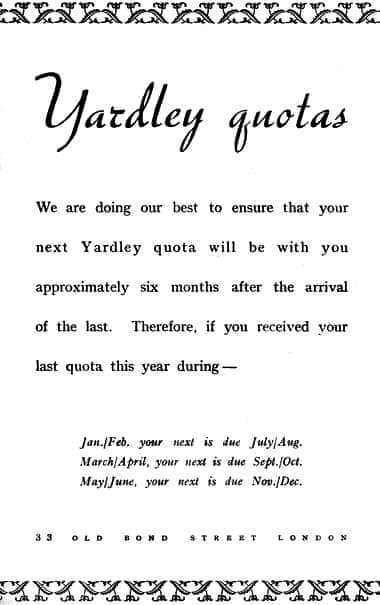
1945 Yardley trade advertisement regarding quotas. VE Day 8th May.
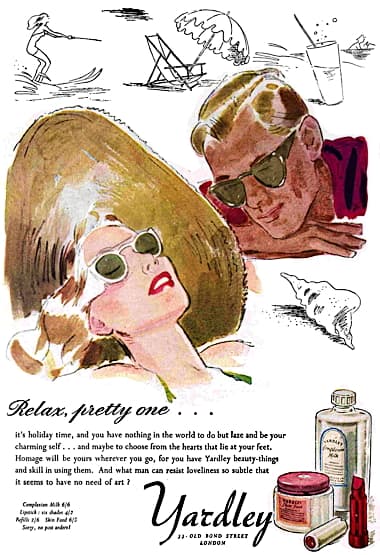
1946 Yardley Skin Food, Complexion Milk, and Lipsticks.
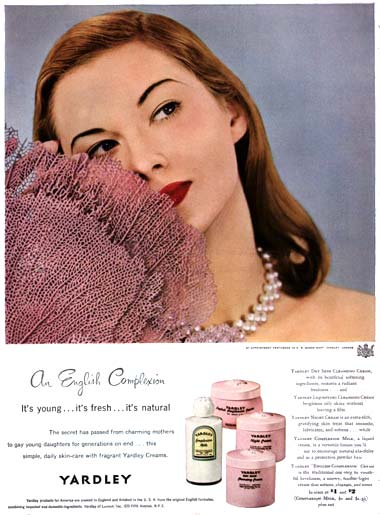
1947 Yardley English Complexion Cream, Night Cream, Dry Skin Cleansing Cream and Complexion Milk in new packaging introduced in 1946.
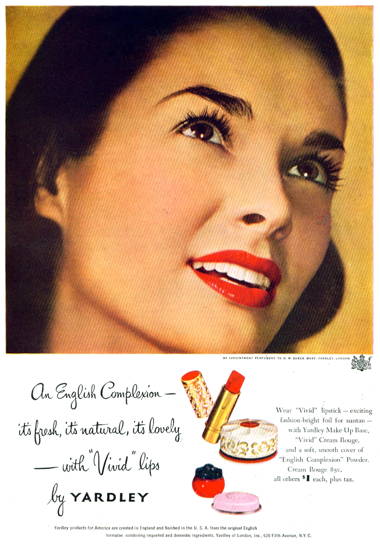
1947 Yardley Vivid lipstick.
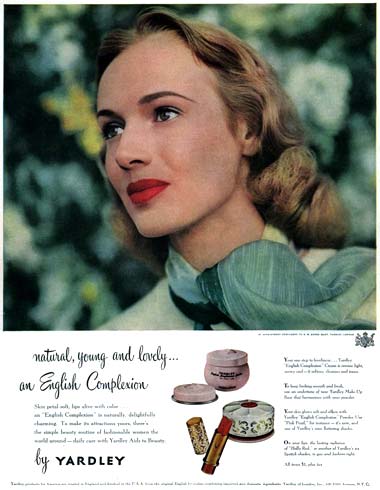
1948 Yardley English Complexion Cream, Make-up Base, English Complexion Powder (Fish Pearl) and Lipstick (Holly Red).
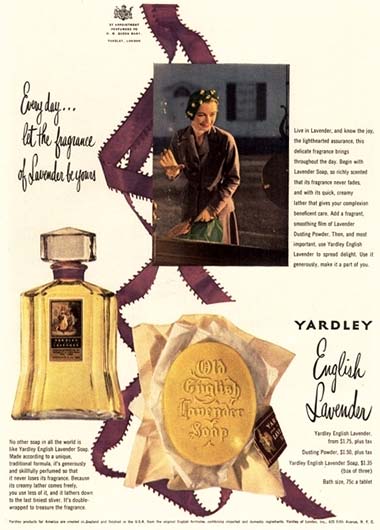
1950 Yardley English Lavender Fragrance and English Lavender Soap.
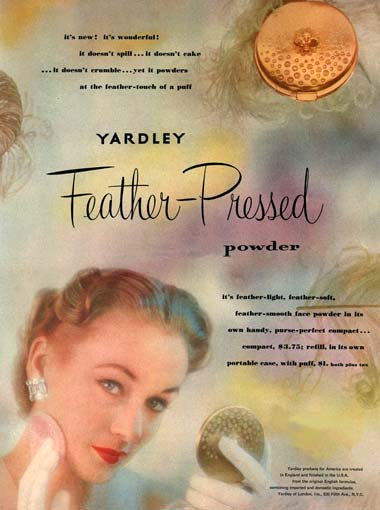
1951 Yardley Feather Pressed Powder Compact with bee and pollen motifs on the lid. Shades included Special Rachel, Rose Pearl, Rose Rachel and Rose Peach.
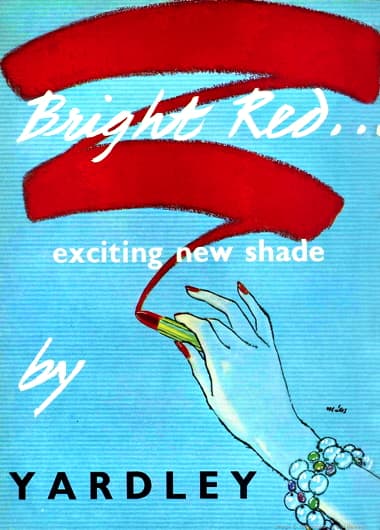
1952 Yardley Bright Red.
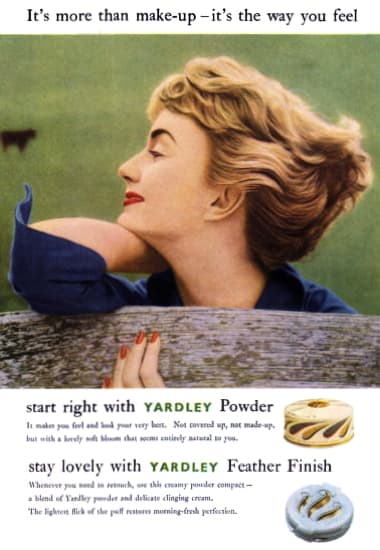
1956 Yardley Powder and Feather Finish pressed powder compact.
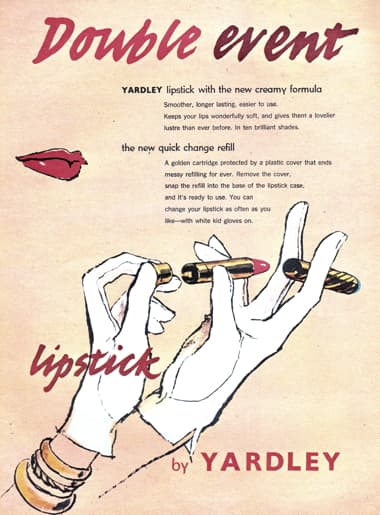
1956 Yardley refill lipstick.
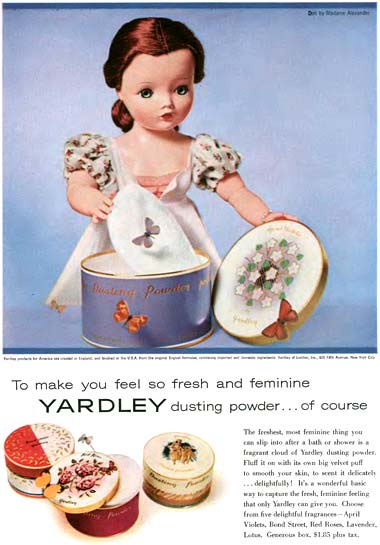
1957 Yardley Dusting Powders.
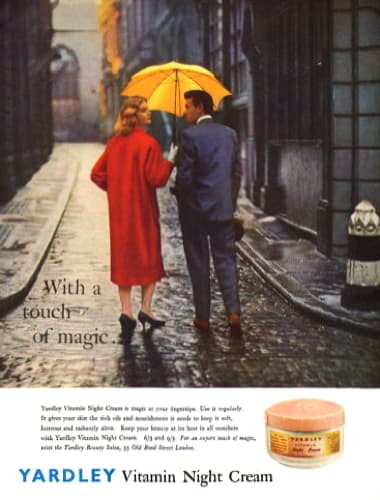
1957 Yardley Vitamin Night Cream.
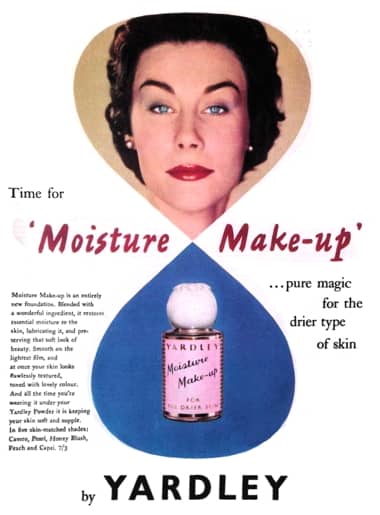
1958 Yardley Moisture Make-up for drier skins.
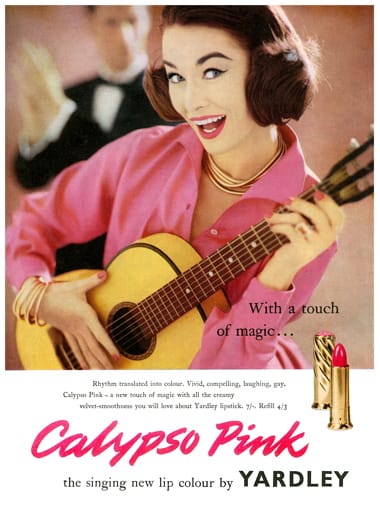
1958 Yardley Calypso Lipstick. This pink colour was introduced in 1958.
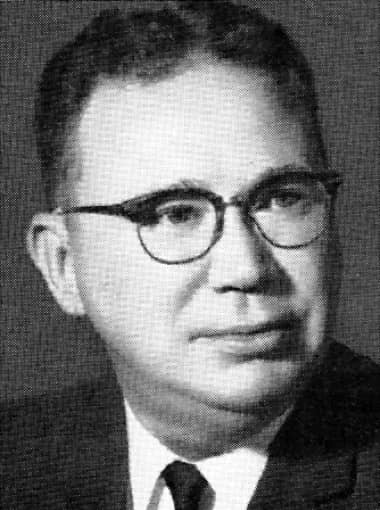
Sabbat J. Strianse [1913-1991]. Strianse was well known in cosmetic chemistry circles, having been elected president of the Society of Cosmetic Chemists in 1957.
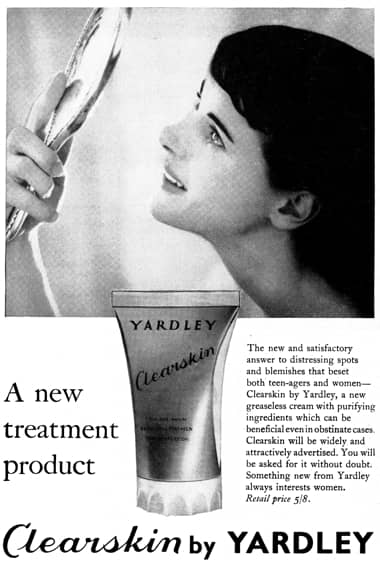
1959 Industry advertisement for Yardley Clearskin.
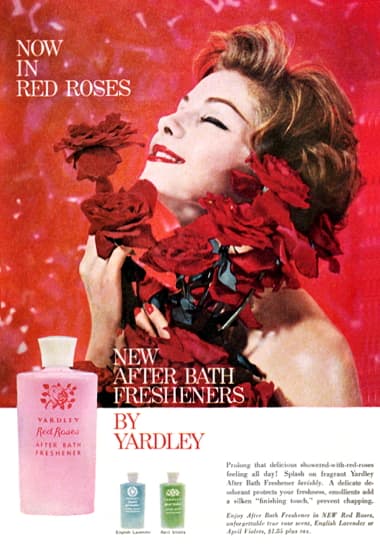
1959 Yardley After Bath Fresheners.
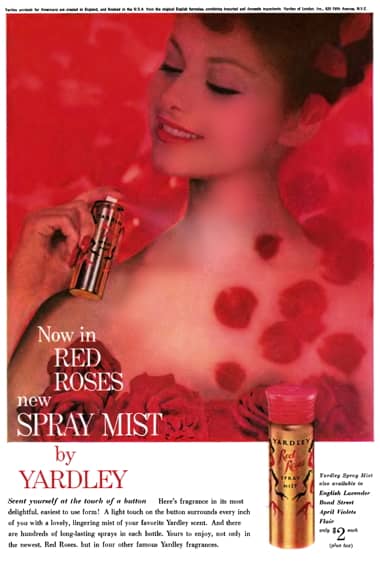
1959 Yardley Spray Mist.
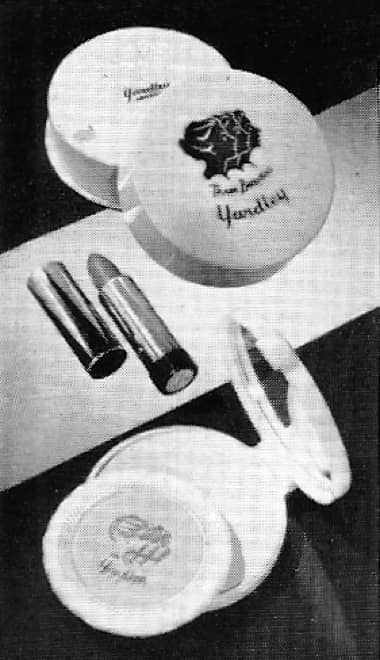
1959 Yardley Three Beauties Powder, Lipstick and Cream Powder in shades developed for the Asian market.
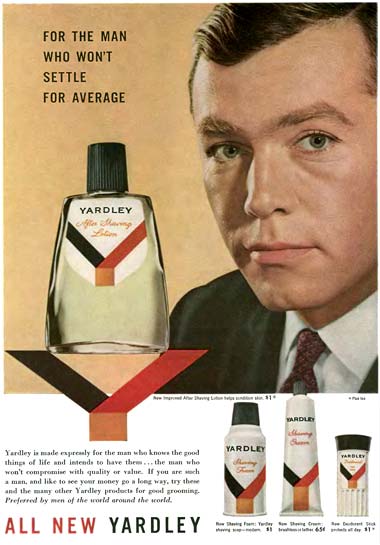
1959 Yardley Men’s Toiletries. There are some suggestions that the bold Y was used to suggest the masculine Y chromosome.
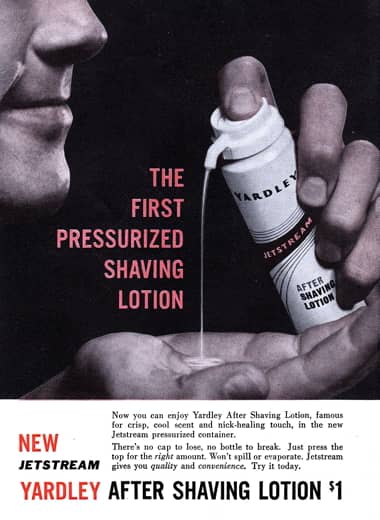
1959 Yardley Jetstream After Shaving Lotion.
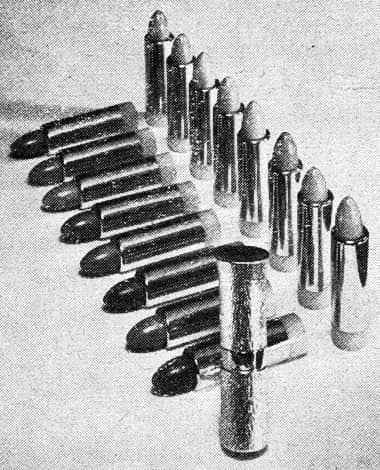
1960 Yardley Florentine Lipsticks.
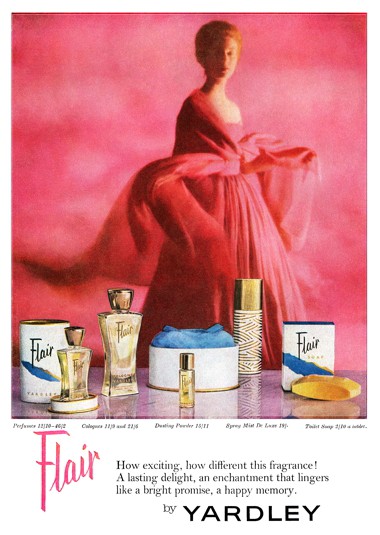
1962 Yardley Flair.
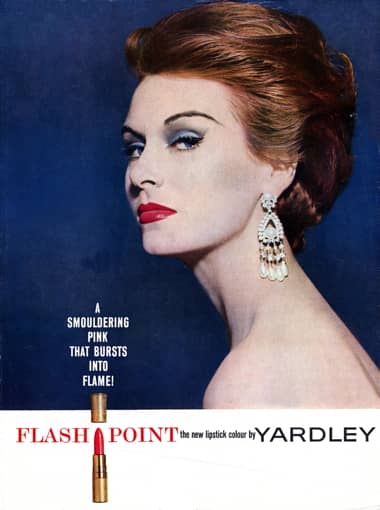
1962 Yardley Flashpoint.
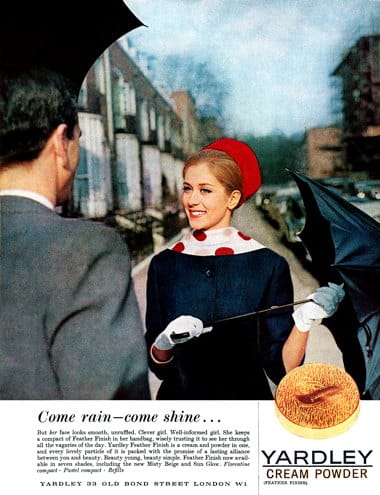
1962 Yardley Powder Cream.
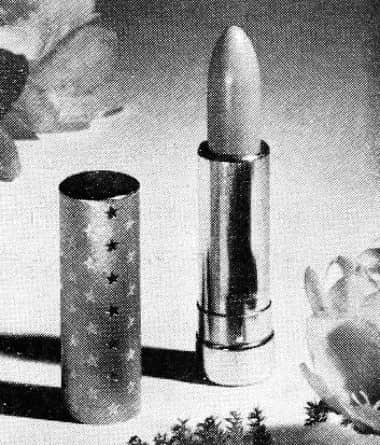
1963 Yardley Moisture Creme Lipstick.
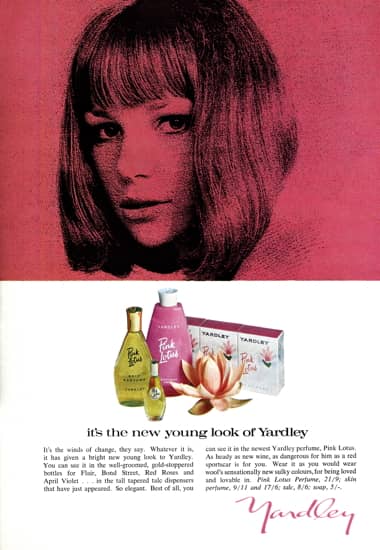
1964 Yardley Pink Lotus.
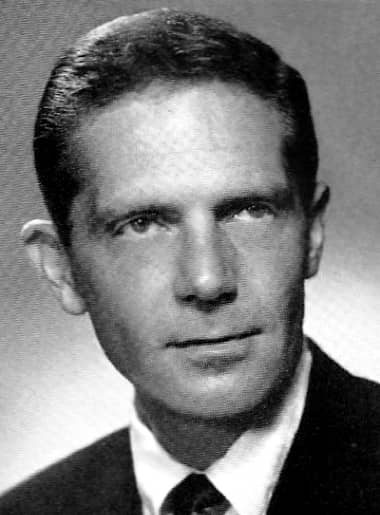
Donald David Burr [1923-1990].
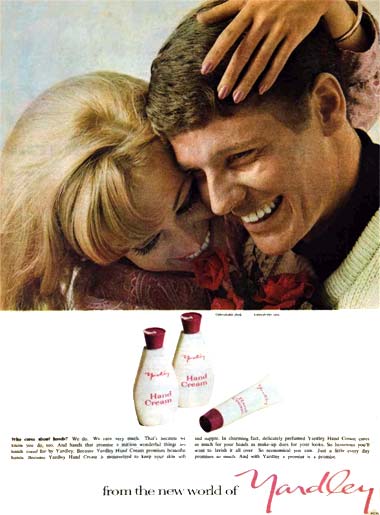
1965 Yardley Hand Lotion. Part of the New World of Yardley promotion.
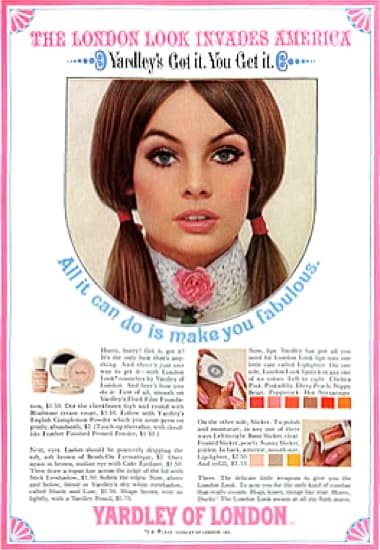
1965 Yardley of London. Make-up typical of the London Look;. A baby doll, pale, matt finish to the skin and a heavy focus on the eyes.
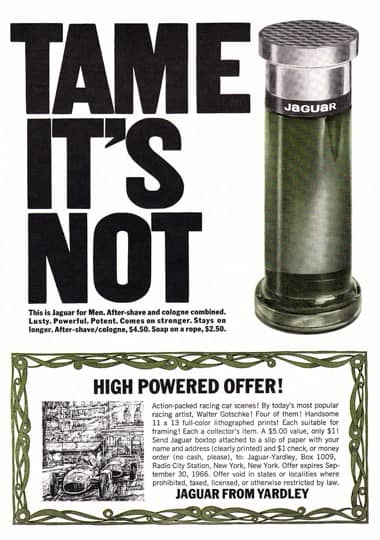
1966 Yardley Jaguar for Men Aftershave and Cologne.
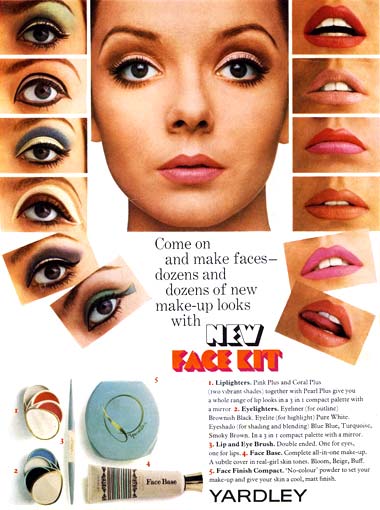
1967 Yardley Face Kit.
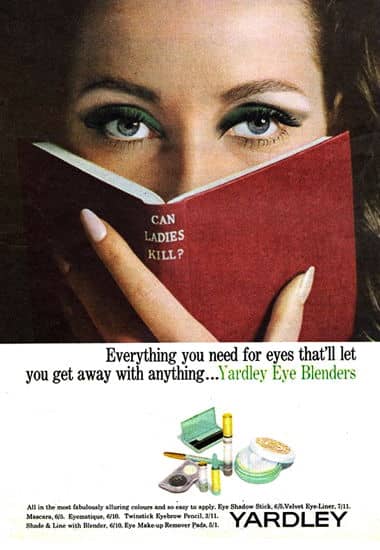
1967 Yardley Eye Blenders.
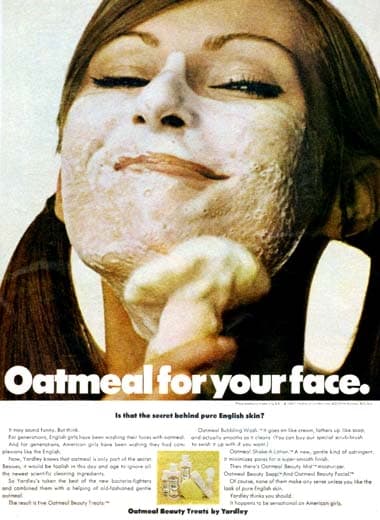
1967 Yardley Oatmeal Scrub. Yardley sold a complete range of oatmeal-based products under the banner of Oatmeal Beauty Treats. Other products aimed at adolescent skin problems included Yardley Clearskin and Yardley Medicated Beauty Finish.
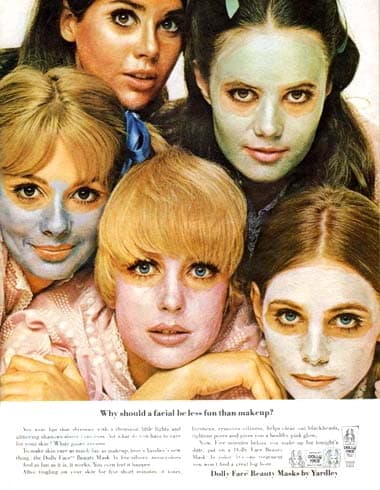
1967 Yardley Dolly Face Beauty Masks.
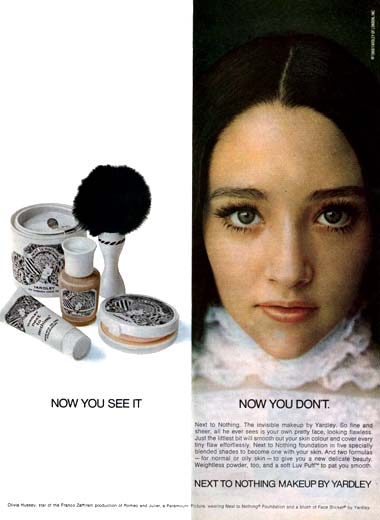
1968 Yardley Next to Nothing Make-up.
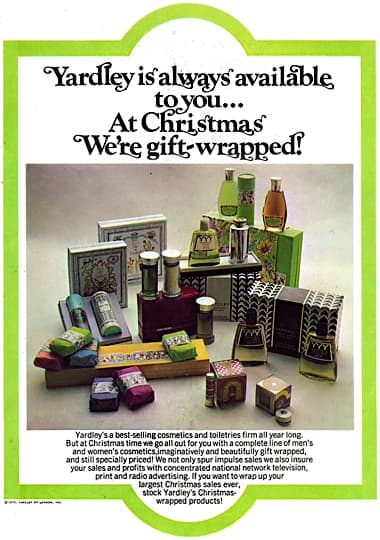
1970 Yardley Christmas suggestions.

1972 Interior of the Yardley factory in Basildon.
